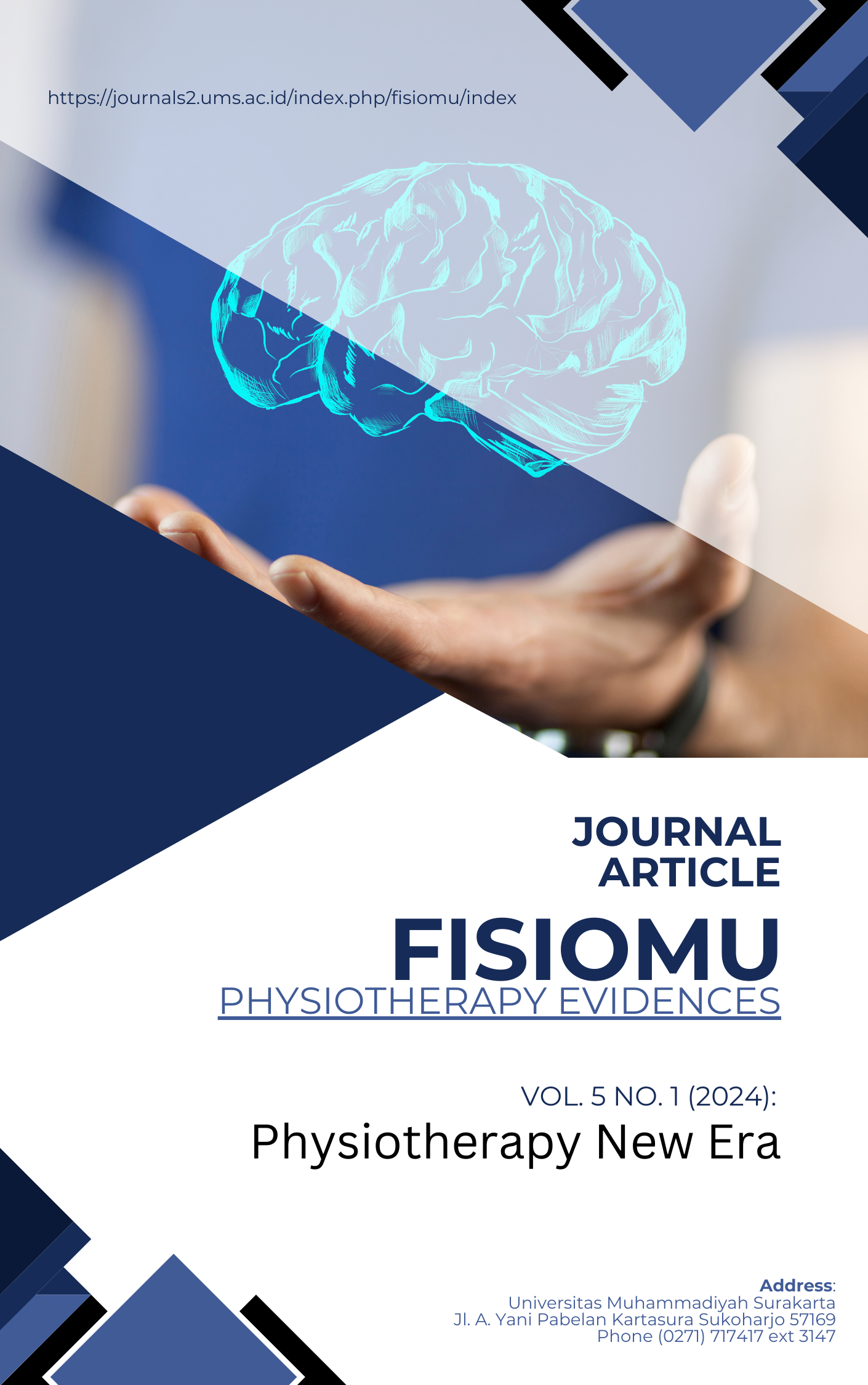Pilot Study: Different Leg Muscle Activation When Walking on Stable, Unstable & Slippery Floors
(Parameters Using Surface Electromyograph)
DOI:
https://doi.org/10.23917/fisiomu.v5i1.2715Abstract
Introduction: Muscle activation is the interaction of intracellular cell fluid and extracellular cell fluid that occurs in the cell membrane channel and can also be defined as the movement of muscle contraction and relaxation accompanied by changes in muscle fibre length. To determine differences in muscle activation in the legs (m. gastrocnemius, m. tibialis anterior, m. rectus femoris, m. biceps femoris longum, m. gluteus maximus) when walking in various floor/base conditions (stable, unstable, and slippery) using a Surface Electromyograph (sEMG). Methods: The research method used is Experimental Single Group Design where the researcher involves only 1 group consisting of 5 subjects. Results: The results of this study first used the repeat ANOVA test with scores obtained on stable floor conditions (0.000), unstable floor conditions (0.000), and slippery floor conditions (0.000). Conclusion: From the results of research that has been carried out, it can be concluded that there are differences in leg muscle activation as measured using Surface Electromyograph (sEMG) when walking on a stable, unstable, and slippery floor.
Downloads
References
Callis, N. (2016). Falls Prevention: Identification of Predictive Fall Risk Factors. Applied Nursing Research, 29;53–58. DOI: https://doi.org/10.1016/j.apnr.2015.05.007
Chander, H., Garner, J.C., Wade, C., & Knight, A.C. (2021). Lower Extremity Muscle Activation in Alternative Footwear During Stance Phase of Slip Events. International Journal of Environmental Research and Public Health, 18(4);1–12. DOI: https://doi.org/10.3390/ijerph18041533
Fatmarizka, T., Carissa, V.J.D., & Susilo, T.E. (2023). Spatiotemporal Gait Changes During Pregnancy: A Literature Review. FISIO MU: Physiotherapy Evidences, 4(2);161-168. DOI: https://10.23917/fisiomu.v4i2.22228
Jafarnezhadgero, A.A., Fatollahi, A., Amirzadeh, N., Siahkouhian, M., & Granacher, U. (2019). Ground Reaction Forces and Muscle Activity while Walking on Sand versus Stable Ground in Individuals with Pronated Feet Compared with Healthy Controls. PLoS ONE, 14(9);1–15. https://doi.org/10.1371/journal.pone.0223219
Junaidi, S. (2011). Pembinaan Fisik Lansia melalui Aktivitas Olahraga Jalan Kaki. Media Ilmu Keolahragaan Indonesia, 1(1);17-21. DOI: https://doi.org/10.15294/miki.v1i1.1130
Krogt, V.D.M.M., Delp, S.L., & Schwartz, M.H. (2012). How Robust is Human Gait to Muscle Weakness? Gait and Posture, 36(1);113–119. DOI: https://doi.org/10.1016/j.gaitpost.2012.01.017
Mason, A.N., Lum, J., Milligan, A., & Robinson, J. (2018). Functional Reach Test. Crit Rev Phys Rehab Med. 29(1).
Muyor, J.M., Martín-Fuentes, I., Rodríguez-Ridao, D., & Antequera-Vique, J.A. (2020). Electromyographic Activity in the Gluteus Medius, Gluteus Maximus, Biceps Femoris, Vastus Lateralis, Vastus Medialis and Rectus Femoris during the Monopodial Squat, Forward Lunge and Lateral Step-Up Exercises. PLoS ONE. 15(4);1–15. DOI: https://doi.org/10.1371/journal.pone.0230841
Noor, Z. (2016). Gangguan Muskuloskeletal. Jakarta Selatan: Salemba Medika.
Park, S-H. & Lee, Y-S. (2017). The Diagnostic Accuracy of the Berg Balance Scale in Predicting Falls. Western Journal of Nursing Research, 39(11);1502–1525. DOI: https://doi.org/10.1177/0193945916670894
Pristianto, A. & Perdana, S.S. (2023). Biomekanik Klinis. Muhammadiyah University Press: Surakarta.
Pristianto, A., Susilo, T.E., & Setiyaningsih, R. (2018). Penerapan Functional Movement Screening (FMS) Untuk Pencegahan Cidera Olahraga Pada Komunitas Kalistenik Solo. Proceeding of the 8th University Research Colloquium 2018: Bidang MIPA dan Kesehatan, 267–271. Retrieved from: http://repository.urecol.org/index.php/proceeding/article/view/350
RISKESDAS. (2018). Hasil Utama Riset Kesehatan Dasar. Retrieved from: https://kesmas.kemkes.go.id/assets/upload/dir_519d41d8cd98f00/files/Hasil-riskesdas-2018_1274.pdf
Robertson, R., Robertson, A., Jepson, R., & Maxwell, M. (2012). Walking for Depression or Depressive Symptoms: A Systematic Review and Meta-analysis. Mental Health and Physical Activity, 5(1); 66–75. DOI: https://doi.org/10.1016/j.mhpa.2012.03.002
Susilo, T.E. (2023). Effect of Backpack Load on Gait Speed During Walking among University Students: A Pilot Study. FISIO MU: Physiotherapy Evidences, 4(1);78-82. DOI: https://10.23917/fisiomu.v4i1.21401
Svenningsen,F.P., de Zee, M., & Oliveira, A.S. (2019). The Effect of Shoe and Floor Characteristics on Walking Kinematics. Human Movement Science, 66;63–72. DOI: https://doi.org/10.1016/j.humov.2019.03.014
Downloads
Submitted
Accepted
Published
How to Cite
Issue
Section
License
Copyright (c) 2023 Fisio Mu : Physiotherapy Evidaces Journal

This work is licensed under a Creative Commons Attribution-NonCommercial-NoDerivatives 4.0 International License.

This work is licensed under a Creative Commons Attribution-NonCommercial 4.0 International License.
Authors who publish with FISIO MU: Phsiotherapy Evidences agree to the following terms:
- Author(s) retain copyright and grant the journal right of first publication with the work simultaneously licensed under a Creative Commons Attribution-NonCommercial 4.0 International License that allow others to share the work within an acknowledgement of the work’s authorship and initial publication of this journal.
- Author(s) are able to enter into separate, additional contractual arrangement for the non-exclusive distribution of the the journal’s published version of the work (e.g. acknowledgement of its initial publication in this journal).
- Author(s) are permitted and encouraged to post their work online (e.g. in institutional repositories or on their websites) prior to and during the submission process, as it can lead to productive exchanges, as well as earlier and greater citation of published works.












